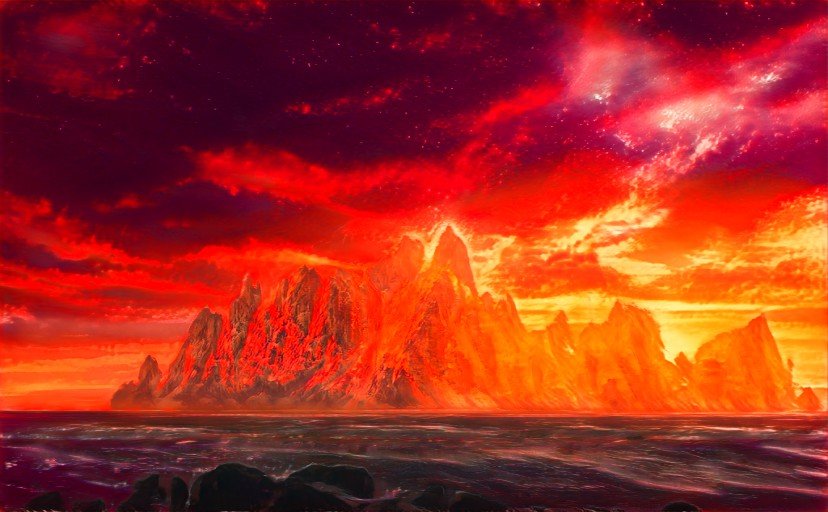Izilakur
Artist's rendition of the early formation of Izilakur, approximately two months after the disaster.
The Shot Heard 'Round the World
The end of the Great War of Adin was marked by the firing of a single shot from the Adinite's artillery cannon fired from the coast of Kibalagaldi. Its target was the massive fleet of Sherdasan ships, more than half their navy, and the floating fortress out in the middle of the ocean. The shell was intended to break apart when it impacted, exposing the massive inner core of cesium to the water and destroying everything around it. Some miscalculation occurred, and the shell dropped into the water without detonating. When it hit the ocean floor, the shell cracked open and the violent reaction began. Instead of vaporizing the ocean above along with the Sherdasan navy, it struck very near an ancient fault line on the bottom of the ocean.Cataclysm
Volatile gasses from the detonation and from the resulting supervolcano still succeeded in sinking the floating citadel and the ships above, but the damage didn't end there. When the initial fireworks had ended, the boiling sea rushed back in to fill the space. A new island began to rise above the surface, as deep wounds in the fault line below continued pouring out magma. The eruption of Izilakur has continued for several years, through present day. Though calmer than it was in its infancy, with fissures continuing to spread lava out to expand the island, the main crater at the center is still active. Lava flows constantly down its slopes, and tephra rains down around The Sea of Souls often.Continuing Effects
The atmosphere of Adin has been darkened by ash since the event, but it is slowly recovering as the dust settles. During The Winter of Peace, Izilakur caused worldwide havoc as crops failed and animals and fish died en masse in the shadowy aftermath. The stars were not seen for two years, and the kursu were able to walk on the surface without protection.Neutral Ground
Under the treaties agreed upon at the end of the war, the island is forbidden to Adinites. Sherdasans may visit to pay their respects to the dead, but no permanent settlements are allowed by either side. Considering the constant minor earthquakes and rains of tephra across even the parts of Izilakur that aren't lava-adjacent, nobody particularly wants to live there anyway. Both Adinite and Sherdasan ships will wait off the coast of the island for a calm period, and then sail in to gather pumice and obsidian from the shoreline. While both of these materials can be shaped from ancient volcanic rock, these newly formed natural samples have value among stone shapers as guides to make stronger configurations of these minerals. Non-shapers will also purchase these, particularly in Sherdasa where shapers are becoming more and more scarce. Obsidian is used there for tools and knives, and the pumice to mix with soil for growing crops. Some Adinites without shaping abilities have learned the practice of knapping obsidian from the Sherdasans, allowing them to make their own implements as well.Current Day
Recently, visitors to Izilakur have reported seeing golems patrolling the island, massive constructs of igneous stone or obsidian that appear roughly humanoid. They lumber slowly towards anyone that lands on shore, Adinite or Sherdasan, and wisely no crew has stayed around to see what they want. No nation has claimed responsibility for these golems, but sightings are becoming more regular. While it would be no hard task for the Adinites to bring in soil and plants to start the process of primary succession, the treaties, golems, and raining lava prevent them from doing so. Still, the close proximity to three continents and constant visits from scavengers have already introduced fungus to the still volcanic island.
Type
Island




Imagine screwing up so badly at your job, that you accidentally cause nature to create a new island.
Too low they build who build beneath the stars - Edward Young